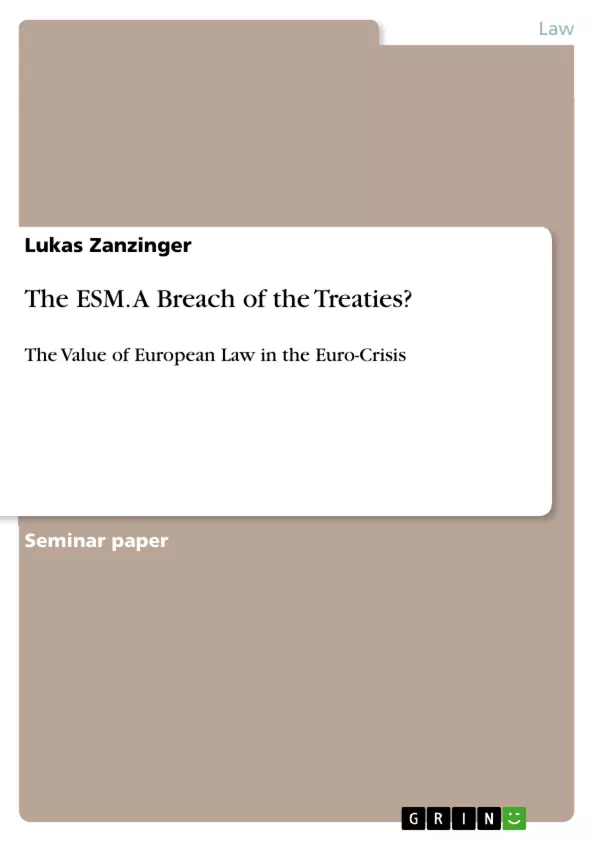The purpose of this paper is to discuss the role of the European Law in the crisis. Laws are rules for a crisis. When humans are living together, that has always been accompanied by conflicts. That’s why law was made. It is a preventive guideline for a future ‘crisis’ - in the small sphere between arguing neighbours, but also for big issues. We will examine how the law was followed here.
The example is the European Stability Mechanism (ESM). After a brief explanation on what the ESM is and why it was established, the compliance with European Law will be discussed by going through the ECJ’s judgement in the “Pringle-Case” from November 2012. Secondly the paper will refer to the German Federal Court’s “ESM- judgement”, which was published two months earlier.
Inhaltsverzeichnis (Table of Contents)
- The ESMA Breach of the Treaties?
- Introduction
- Im Nachhinein ist man immer schlauer...
- Different Interests, different Opinions
- Cyprus
- Banking Union
- OMT
- Euro Bonds
- The Law and the Crisis
- What is the ESM?
- Overview
- The idea: No dependence on the market's rules.
- Legal basis and status
- Situation before the ESM
- The ECJ Pringle-Case
- Correct procedure?
- Only provisions of Part Three?
- Monetary Policy
- Everything already 'clear'?
- Consultation of the ECB
- Coordination of the Member States' economic policies.
- Increases the competences conferred on the Union?
- Summary
- Compliance with the other Treaty Provisions
- Exclusive Union competence
- Monetary policy...
- Conclusion of international agreements
- Prohibition by the Treaties
- Financial assistance by the Union in exceptional cases (Art. 122 (2) TFEU)
- Art. 123 TFEU.
- No-bailout clause.
- National Constitutions and European Law.
- Judgement of the BVerfG of 12 September 2012.
- Overview
- Maastricht Judgement (1992)...
- Treaty of Lisbon (2009).......
- Mangold (2010).
- Financial assistance for Greece and Rescuing of the Euro (2011)
- Application in practice
- The BVerfG's interpretation of the ESM Treaty (TESM).
- The budgetary power of the Parliament
- Limited liability
- Other shares.
- Capital calls.
- Coverage of Losses
- First requirement of the Court
- The German Parliament's right of information
- Prohibition of Disclosure and Immunity
- Interpretation
- Systematic approach.
- Spirit and purpose of the Law.
- Second requirement of the Court..
- Ensuring the BVerfG's interpretation
- Summary.
- The BVerfG's opinion on the ECB's OMT Program.
- Overview
- The principle of Article 123 (2) TFEU
- An unlawful avoidance of the principle?
- Conclusion
- The legal framework of the European Stability Mechanism (ESM).
- The role of the ESM in the Euro-Crisis.
- The interplay between solidarity and liberal approaches in the context of the crisis.
- The implications of the ESM for European Law.
- The impact of the ESM on national constitutions and the balance of power between national and European institutions.
Zielsetzung und Themenschwerpunkte (Objectives and Key Themes)
The objective of this work is to examine the legal value of European Law in the Euro-Crisis, using the example of the European Stability Mechanism. It explores the role of the ESM, particularly in relation to the principle of solidarity versus the liberal approach, and how these principles are reflected in the legal framework.
Zusammenfassung der Kapitel (Chapter Summaries)
The first chapter provides an introduction to the topic by outlining the different interests and opinions surrounding the handling of the Euro-Crisis. It highlights the contrasting views of the liberal approach (whereby states are left to their own devices) and the solidarity model (where states assist one another in times of crisis). The chapter uses the example of Cyprus to demonstrate the real-world implications of these contrasting approaches.
Chapter B delves into the nature of the ESM, providing an overview of its structure, purpose, and legal foundation. It explores the idea of creating a mechanism that would mitigate the dependence of countries on market forces and explain the legal basis and status of the ESM.
Chapter C examines the legal situation prior to the establishment of the ESM, while Chapter D focuses on the ECJ Pringle-Case, analyzing the legal procedures and principles involved. It particularly considers the question of whether the ESM's actions are in compliance with existing Treaty provisions, specifically examining the areas of monetary policy, international agreements, and the prohibition of financial assistance by the Union in exceptional cases.
Schlüsselwörter (Keywords)
This work focuses on the European Stability Mechanism (ESM), the Euro-Crisis, European Law, legal value, solidarity, liberal approach, financial assistance, Treaty provisions, national constitutions, ECJ Pringle-Case, and the European Central Bank (ECB).
- Arbeit zitieren
- Lukas Zanzinger (Autor:in), 2013, The ESM. A Breach of the Treaties?, München, GRIN Verlag, https://www.hausarbeiten.de/document/215125


